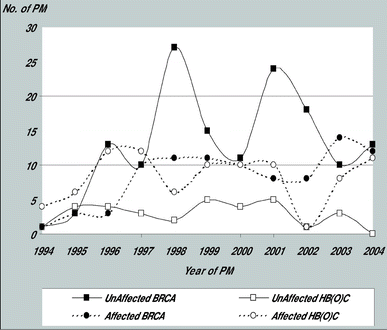Prophylactic mastectomy in BRCA1/2 mutation carriers and women at risk of hereditary breast cancer: long-term experiences at the Rotterdam Family Cancer Clinic
- PMID: 17541692
- PMCID: PMC2077910
- DOI: 10.1245/s10434-007-9449-x
Prophylactic mastectomy in BRCA1/2 mutation carriers and women at risk of hereditary breast cancer: long-term experiences at the Rotterdam Family Cancer Clinic
Abstract
Background: BRCA1/2 mutation carriers and women from a hereditary breast(/ovarian) cancer family have a highly increased risk of developing breast cancer (BC). Prophylactic mastectomy (PM) results in the greatest BC risk reduction. Long-term data on the efficacy and sequels of PM are scarce.
Methods: From 358 high-risk women (including 236 BRCA1/2 carriers) undergoing PM between 1994 and 2004, relevant data on the occurrence of BC in relation to PM, complications in relation to breast reconstruction (BR), mutation status, age at PM and preoperative imaging examination results were extracted from the medical records, and analyzed separately for women without (unaffected, n = 177) and with a BC history (affected, n = 181).
Results: No primary BCs occurred after PM (median follow-up 4.5 years). In one previously unaffected woman, metastatic BC was detected almost 4 years after PM (primary BC not found). Median age at PM was younger in unaffected women (P < .001), affected women more frequently were 50% risk carriers (P < .001). Unexpected (pre)malignant changes at PM were found in 3% of the patients (in 5 affected, and 5 unaffected women, respectively). In 49.6% of the women opting for BR one or more complications were registered, totaling 215 complications, leading to 153 surgical interventions (71%). Complications were mainly related to cosmetic outcome (36%) and capsular formation (24%).
Conclusions: The risk of developing a primary BC after PM remains low after longer follow-up. Preoperative imaging and careful histological examination is warranted because of potential unexpected (pre)malignant findings. The high complication rate after breast reconstruction mainly concerns cosmetic issues.
Figures
Comment in
-
More answers about prophylactic mastectomy.Ann Surg Oncol. 2007 Dec;14(12):3283-4. doi: 10.1245/s10434-007-9507-4. Epub 2007 Sep 25. Ann Surg Oncol. 2007. PMID: 17899294 Free PMC article. No abstract available.
-
Prophylactic surgery in the complex decision-making management of BRCA mutation carriers.Ann Surg Oncol. 2008 Jun;15(6):1788-90; author reply 1791-2. doi: 10.1245/s10434-007-9738-4. Epub 2008 Jan 15. Ann Surg Oncol. 2008. PMID: 18197455 No abstract available.
References
-
- {'text': '', 'ref_index': 1, 'ids': [{'type': 'DOI', 'value': '10.1126/science.1088759', 'is_inner': False, 'url': 'https://doi.org/10.1126/science.1088759'}, {'type': 'PubMed', 'value': '14576434', 'is_inner': True, 'url': 'https://pubmed.ncbi.nlm.nih.gov/14576434/'}]}
- King MC, Marks JH, Mandell JB. Breast and ovarian cancer risks due to inherited mutations in BRCA1 and BRCA2. Science 2003; 302:643–6 - PubMed
-
- {'text': '', 'ref_index': 1, 'ids': [{'type': 'DOI', 'value': '10.1086/301749', 'is_inner': False, 'url': 'https://doi.org/10.1086/301749'}, {'type': 'PMC', 'value': 'PMC1376944', 'is_inner': False, 'url': 'https://pmc.ncbi.nlm.nih.gov/articles/PMC1376944/'}, {'type': 'PubMed', 'value': '9497246', 'is_inner': True, 'url': 'https://pubmed.ncbi.nlm.nih.gov/9497246/'}]}
- Ford D, Easton DF, Stratton M, et al. Genetic heterogeneity and penetrance analysis of the BRCA1 and BRCA2 genes in breast cancer families. Am J Hum Genet 1998; 62:676–89 - PMC - PubMed
-
- {'text': '', 'ref_index': 1, 'ids': [{'type': 'DOI', 'value': '10.1056/NEJM199705153362001', 'is_inner': False, 'url': 'https://doi.org/10.1056/nejm199705153362001'}, {'type': 'PubMed', 'value': '9145676', 'is_inner': True, 'url': 'https://pubmed.ncbi.nlm.nih.gov/9145676/'}]}
- Struewing JP, Hartge P, Wacholder S, et al. The risk of cancer associated with specific mutations of BRCA1 and BRCA2 among Ashkenazi Jews. N Engl J Med 1997; 336:1401–8 - PubMed
-
- {'text': '', 'ref_index': 1, 'ids': [{'type': 'DOI', 'value': '10.1016/S0140-6736(02)11023-3', 'is_inner': False, 'url': 'https://doi.org/10.1016/s0140-6736(02)11023-3'}, {'type': 'PubMed', 'value': '12354469', 'is_inner': True, 'url': 'https://pubmed.ncbi.nlm.nih.gov/12354469/'}]}
- Bergfeldt K, Rydh B, Granath F, Gronberg H, Thalib L, Adami HO, Hall P. Risk of ovarian cancer in breast-cancer patients with a family history of breast or ovarian cancer: a population-based cohort study. Lancet 2002; 360:891–4 - PubMed
-
- {'text': '', 'ref_index': 1, 'ids': [{'type': 'DOI', 'value': '10.1056/NEJM200107193450301', 'is_inner': False, 'url': 'https://doi.org/10.1056/nejm200107193450301'}, {'type': 'PubMed', 'value': '11463009', 'is_inner': True, 'url': 'https://pubmed.ncbi.nlm.nih.gov/11463009/'}]}
- Meijers-Heijboer H, van Geel B, Van Putten WL, et al. Breast cancer after prophylactic bilateral mastectomy in women with a BRCA1 or BRCA2 mutation. N Engl J Med 2001; 345:159–164 - PubMed
MeSH terms
Substances
LinkOut - more resources
Full Text Sources
Other Literature Sources
Medical
Miscellaneous


